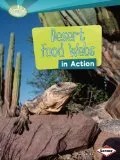Today we were inspired by two new picture books about deserts and desert animals. See full reviews at our sister blog, Wrapped in Foil.
Get to Know Gila Monsters (Get To Know Reptiles) by Flora Brett is a simple text for beginning readers that helps sort myth from facts about this unique lizard found only in the desert Southwest.
A Day and Night in the Desert (Caroline Arnold’s Habitats)
by Caroline Arnold reveals which desert creatures are active during which parts of the day and night. Although it centers on animals and plants found in the Sonoran desert, the book also contains a map showing where deserts are located throughout the world.
Desert Mammals Activity
We often think of cacti and reptiles when we think of deserts, but as A Day and Night in the Desert shows, there are quite a few mammals found in deserts as well.
Some mammals found in deserts:
- Jackrabbits
- Coyotes
- Foxes
- Ringtails
- Coatis
- Skunks
- Cougars
- Bobcats
- Bighorn sheep
- Javelinas
- Bats
- Ground squirrels
- Mice
- Packrats
- Rats
Pick a desert mammal and find out more about it.
For example, is the mammal diurnal or nocturnal? Is it active all year around or does it hibernate for part of the year? What does it eat? What is its life cycle? Does it have any special ways to conserve water in the desert?
 What are these javelinas (also called collared peccaries) doing to keep cool?
What are these javelinas (also called collared peccaries) doing to keep cool?
Create a lapbook, poster, diorama, or report about your findings.
Resources to check:
1. The AZ-Sonora Desert Museum has an extensive list of fact sheets about desert bats as well as fact sheets about other desert animals and plants.
2. Pima Community College in Tucson has online facts about desert mammals
3. Arizona Naturalists has information about Sonora desert mammals
4. Tohono Chul Gardens has a number of desert related handouts on their website. Scroll down to “Fun and Smart Projects for Kids,” and look for links to the Desert Pathfinders Activity Booklet (this link takes you directly to the .pdf), Saguaros, etc.
5. Look for the Desert Habitats activities page on our Growing With Science website.
Looking for a list of more books for kids about desert habitats? Try our growing list at Science Books for Kids.
Disclosures: These books were provided by the publisher for review purposes. I am an affiliate for Amazon, and if you click through the linked titles or ads and make a purchase, I will receive a small commission at no extra charge to you. Proceeds will be used to maintain this self-hosted blog.
Come visit the STEM Friday blog each week to find more great Science, Technology, Engineering and Math books.







